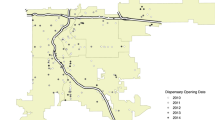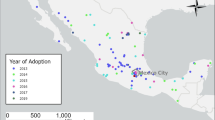Abstract
Objectives
This paper reports a quasi-experimental evaluation of California’s 1996 medical marijuana law (MML), known as Proposition 215, on statewide motor vehicle fatalities between 1996 and 2015.
Methods
To infer the causal impact of California’s MML enactment on statewide motor vehicle fatalities, we construct a synthetic control group for California (i.e., California had it NOT enacted MMLs) as a weighted sum of annual traffic fatality time series from a donor pool of untreated (no MML) states. The post-MML difference between California and its constructed counterfactual reflects the net effect of MMLs on statewide traffic fatalities. The synthetic control group design avoids the problematic homogeneity assumptions intrinsic to panel regression models, which have been employed in prominent studies of this topic.
Results
California’s 1996 MML appears to have produced a large, sustained decrease in statewide motor vehicle fatalities amounting to an annual reduction between 588 and 900 vehicle fatalities. This finding is consistent across a wide range of model specifications and donor pool restrictions. In-sample placebo test results suggest that the estimated intervention effect is unlikely to be a spurious artifact and the “leave-one-out” sensitivity analysis demonstrates that the effect is not being driven by an individual or ensemble of influential donor pool states.
Conclusions
Our focus on California as a case study limits our ability to generalize our estimate of the MML intervention on motor vehicle fatalities in California to other MML states; however, state-level MML interventions have major differences in their policy dimensions that seem unlikely to “average out” through aggregation.




Similar content being viewed by others
References
Abadie, A., Diamond, A., & Hainmueller, J. (2010). Synthetic control methods for comparative case studies: Estimating the effect of California’s tobacco control program. Journal of the American statistical Association, 105(490), 493–505.
Abadie, A., Diamond, A., & Hainmueller, J. (2011). Synth: an r package for synthetic control methods in comparative case studies. Journal of Statistical Software, 42(13).
Abadie, A., Diamond, A., & Hainmueller, J. (2015). Comparative politics and the synthetic control method. American Journal of Political Science, 59(2), 495–510.
Abadie, A., & Gardeazabal, J. (2003). The economic costs of conflict: a case study of the Basque Country. American Economic Review, 113–132.
Anderson, D. M., Hansen, B., & Rees, D. I. (2013). Medical marijuana laws, traffic fatalities, and alcohol consumption. Journal of Law and Economics, 56, 333–369.
Asbridge, M., Hayden, J., & Cartwright, J. (2012). Acute cannabis consumption and motor vehicle collision risk: Systematic review of observational studies and meta-analysis. British Medical Journal, 344, e536.
Bates, M. N., & Blakely, T. A. (1999). Role of cannabis in motor vehicle crashes. Epidemiologic Reviews, 21, 222–232.
Braun, B. L., Tekawa, I. S., Gerberich, S. G., & Sidney, S. (1998). Marijuana use and medically attended injury events. Annals of Emergency Medicine, 32, 353–360.
Busby, A.M. (2010) Seeking a second opinion: how to cure Maryland’s medical marijuana law. University of Baltimore Law Review, 139–181.
Chaloupka, F. J., & Laixuthai, A. (1997). Do youths substitute alcohol and marijuana? Some econometric evidence. Eastern Economic Journal, 23, 253–276.
Crost, B., & Guerrero, S. (2012). The effect of alcohol availability on marijuana use: evidence from the minimum legal drinking age. Journal of Health Economics, 31, 112–121.
DiNardo, J., & Lemieux, T. (2001). Alcohol, marijuana, and American youth: the unintended consequences of government regulation. Journal of Health Economics, 20, 991–1010.
Fairman, B. J. (2016). Trends in registered medical marijuana participation across 13 US states and District of Columbia. Drug and Alcohol Dependence, 159, 72–79.
Farrelly, M. C., Bray, J. W., Zarkin, G. A., Wendling, B. W., & Pacula, R. L. (1999). The effects of prices and policies on the demand for marijuana: evidence from the National Household Surveys on drug abuse. working paper 6940. National Bureau of Economic Research.
Gerberich, S. G., Sidney, S., Braun, B. L., Tekawa, I. S., Tolan, K. K., & Quesenberry, C. P. (2003). Marijuana use and injury events resulting in hospitalization. Annals of Epidemiology, 13, 230–237.
Greene, W. H. (2003). Econometric analysis (5th ed.). Upper Saddle River, NJ: Prentice-Hall.
Heckman, J. J., Ichimura, H., & Todd, P. E. (1997). Matching as an econometric evaluation estimator: Evidence from evaluating a job training programme. The Review of Economic Studies, 64, 605–654.
Holland, P. W. (1986). Statistics and causal inference. Journal of the American statistical Association, 81(396), 945–960.
Im, K. S., Pesaran, M. H., & Shin, Y. (2003). Testing for unit roots in heterogeneous panels. Journal of Econometrics, 115, 53–74.
Kann, L., Warren, C. W., Harris, W. A., Collins, J. L., Williams, B. I., Ross, J. G., & Kolbe, L. J. (1996). Youth risk behavior surveillance—United States, 1995. Journal of School Health, 66, 365–377.
Mayr, E. (1997). This is biology: the science of the living world. Cambridge, MA: Harvard University Press.
McCleary, R., McDowall, D., & Bartos, B. (2017). Design and analysis of time series experiments. Oxford University Press.
National Highway Traffic Safety Administration. (2014). FARS analytic reference guide 1975 to 2014. Washington, DC: Department of Transportation.
Pacula, R. L. (1998). Does increasing the beer tax reduce marijuana consumption? Journal of Health Economics, 17, 557–585.
Pacula, R. L., Powell, D., Heaton, P., & Sevigny, E. L. (2015). Assessing the effects of medical marijuana laws on marijuana use: the devil is in the details. Journal of Policy Analysis and Management, 34(1), 7–31.
Powell, D., Pacula, R. L., & Jacobson, M. (2015). Do medical marijuana laws reduce addictions and deaths related to pain killers? Working Paper 21345, National Bureau of Economic Research. July, 2015.
Rubin, D. B. (1974). Estimating causal effects of treatments in randomized and nonrandomized studies. Journal of Educational Psychology, 66, 688–701.
Rubin, D. B. (2005). Causal inference using potential outcomes. Journal of the American Statistical Association, 100, 322–331.
Saffer, H., & Chaloupka, F. J. (1999). The demand for illicit drugs. Economic Inquiry, 37, 401–411.
Vitiello, M. (1998). Proposition 215: de facto legalization of pot and the shortcomings of direct democracy. University of Michigan Journal of Law Reform, 31, 707–776.
Williams, J., Pacula, R. L., Chaloupka, F. J., & Wechsler, H. (2004). Alcohol and marijuana use among college students: Economic complements or substitutes? Health Economics, 13, 825–843.
Windelband, W. (1894). Geschichte der alten Philosophie: Nebst einem anhang: abriss der Geschichte der Mathematik und Naturwissenschaften. In Altertum von Siegmund Gunter. Munich: Beck.
Acknowledgements
This research was conducted using publicly available data and did not receive any external support or funding.
Data availability statement
The datasets generated and analyzed during the current study are available in the Harvard Dataverse repository, [URL temporarily censored to avoid compromising blind review].
Author information
Authors and Affiliations
Corresponding author
Ethics declarations
Conflict of interest
The authors declare that they have no conflict of interest.
Additional information
Publisher’s Note
Springer Nature remains neutral with regard to jurisdictional claims in published maps and institutional affiliations.
Appendices
Appendix 1. Synthetic control group algebra
Suppose that \( {Y}_{it}^M \) is given by a factor model,
where δt is an unknown common factor with constant factor loadings across units, Zi is a (r × 1) vector of observed covariates that are unaffected by the intervention, θt is a (1 × r) vector of unknown parameters, λt is a (1 × F) vector of unobserved common factors, μt is an (F × 1) vector of unknown factor loadings, and the error terms εit are unobserved transitory shocks at the region level with zero mean.
Let W = (w2, …, wJ + 1) be a (J × 1) vector of donor pool unit weights, selected via a constrained quadratic programming optimization routine, to minimize (X1-X0W)′V(X1-X0W). Where X1 is a (K × 1) vector of pre-intervention values of K predictive factors of outcome Y for the treated unit, X0 is a (K × J) matrix of the same K predictive factors for the untreated units, and V is a (K × K) positive definite matrix whose diagonal elements are weights reflecting the relative importance of the factors in X1 and X0. Each value of the vector W represents a potential synthetic control (i.e., a weighted combination of control units). The value of the outcome variable Y for each synthetic control indexed by W is
Therefore,
As Abadie, Diamond, and Hainmueller (2010) note, we assume that the error terms εit are independent across units and time. However, the unobserved residual uit = λtμt + εit may be correlated across units and time regardless of the assumed independence of εit because of the presence of the term λtμt. If the term λt is assumed to be constant for all times t, then Eq. (1) produces the traditional fixed-effects difference-in-differences model. Since the model presented in Abadie, Diamond, and Hainmueller (2010) allows the effect of unobserved confounders to vary over time, taking time differences does not eliminate the potential bias of unobserved confounders μt. Suppose that there are \( \left({w}_2^{\ast },\dots, {w}_{J+1}^{\ast}\right) \) such that
then the effect of the intervention can be estimated as the difference between the observed outcome variable \( {Y}_{it}^M \)and the estimated outcome for the synthetic control unit:
Equation (3) can hold exactly only if (Y11,...,Y1T0,\( {\boldsymbol{Z}}_1^{\acute{\mkern6mu}} \)) belongs to the convex hull of {(Y21,...,Y2T0, \( {\boldsymbol{Z}}_2^{\acute{\mkern6mu}} \)), ..., (YJ + 11,...,YJ + 1T0,\( {\boldsymbol{Z}}_{J+1}^{\acute{\mkern6mu}} \))}. Often, no set of weights exists that would allow for Eq. (3) to hold exactly. When that is the case, weights are selected so that Eq. (3) holds approximately.
Appendix 2.
Rights and permissions
About this article
Cite this article
Bartos, B.J., Newark, C. & McCleary, R. Marijuana medicalization and motor vehicle fatalities: a synthetic control group approach. J Exp Criminol 16, 247–264 (2020). https://doi.org/10.1007/s11292-018-9345-3
Published:
Issue Date:
DOI: https://doi.org/10.1007/s11292-018-9345-3




